CHAPTER ELEVEN
NEW MARKETS IN THE MILLENNIUM
After the demise of the Mark 2 compact saloon in the late 1960s, Jaguar concentrated on their top-end luxury model, the XJ. Those cars served them well for many years but allowed other manufacturers like BMW and Mercedes to seize what would turn out to be an increasingly important market with their smaller prestige models like the 5 Series and E-Class.
With financial and technical support from Ford, Jaguar launched the S-Type (code X-200) medium-sized saloon in 1999. So successful was the car, that in 2001 a further new model, the X-Type, appeared to challenge even smaller prestige saloons like the BMW 3 Series. Jaguar’s first venture into smaller cars since the 1.5-liter SS Jaguar saloons from the 1930s, this move also proved successful, giving Jaguar a four-model line-up at the turn of the century (X-Type, S-Type, XJ, and XK).
With a need to grasp modern technology and ensure the continued future of the big luxury saloon, Jaguar made great strides forward when the new XJ (coded X-350) was launched in 2003. This completed the make-up of models for the millennium seeing the business through another interesting period and to yet another new owner, Tata of India.
1998–2000: The S-type Reborn
It was at the British Motor Show in 1998 that the name Jaguar S-Type was seen for the first time in thirty years, reestablishing a medium-sized saloon in a market that the company had dominated in the 1950s and 1960s. Jaguar aimed the new car at a younger male and female market and fleet buyers who had previously not purchased an XJ due to its size and price.
The S-Type was virtually an entirely new car from Jaguar’s perspective, although it retained the AJ-V-8 4.0-liter engine first seen in the 1996 XK and 1997 XJ.
The foundation for the new car was a floorpan jointly developed with Ford for both the S-Type and US Lincoln LS. It was built in the States and shipped over to Jaguar’s factory along with other structural pressings. Other specific body components were produced in the UK to meet specific S-Type needs. Many new and innovative design features were built into the car like the limousine-style doors, where the top edge extended into the roof for ease of entry/exit and to eliminate wind noise. The side of the body was formed in a single piece from the A-post to the rear wing (over 3.5 meters in length) for a stable structure and ease of manufacture. Special steel that hardened with the paint process was used for vulnerable areas like the bonnet, door skins, and front wings. A one-piece structured pressing was used for the bonnet to provide the many curves required by the styling. The front end was built as a single piece in plastic for safety, and plastic was also used for the sill covers. Hydroform technology was used to inject oil into the steel tubes of items like the radiator crossmember. Eighty-five percent of the body was double-sided zinc coated. The car had triple door seals and computerized body assembly; laser alignment ensured an excellent ft and finish. All the body panels were made for ease of access and replacement with smaller service panels available to avoid the need for full panels during a repair.
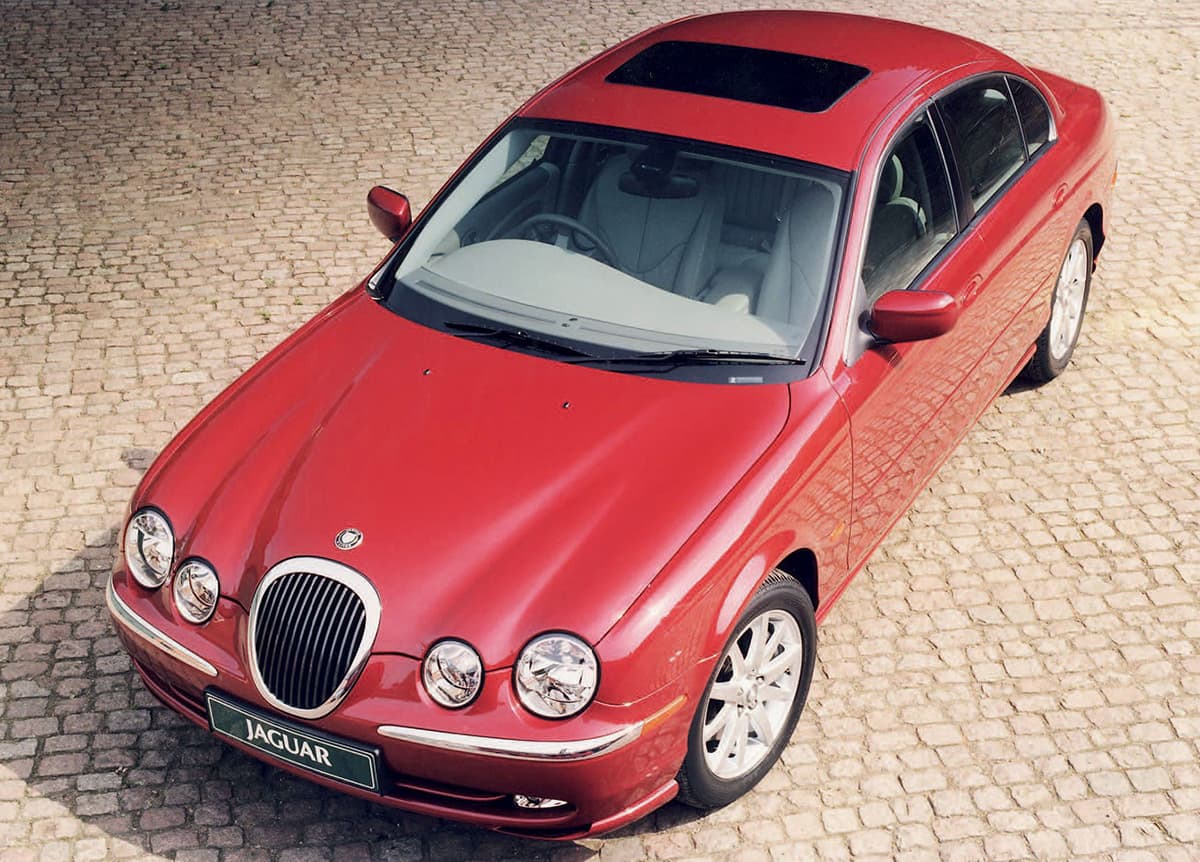
The Jaguar S-Type, first return to the medium-sized luxury saloon market. An all new design separated it from Jaguar’s traditional saloon styling in the XJ.
The external styling of the car was pure Jaguar, designed by their then Chief Styling Director Geoff Lawson. The backward-sloping frontal aspect incorporated a radiator grille resembling both the Mark 2 from the 1960s and the C-Type sports/racing car of the 1950s, flanked by quad elliptical headlamps with impact resistant polycarbonate lenses. The substantial front bumper incorporated an air intake beneath with space for foglamps; on top were twin chromed “blade” finishers. The beautifully sculptured bonnet panel, hinged at the rear, incorporated a growler badge and led to a large raked windscreen.
The large glass area to the doors and screen aided visibility and added light to the interior of the car. The sides of the car incorporated two swage lines and rubbing strips and the body swept down to the rear wing area. The rear provided a little hint to previous Jaguar styling with a matching curved bumper with chrome blades, a large boot lid, and wraparound lighting.
Internally, it was all new again, certainly with a more youthful approach to design available with leather and wood veneer, with the option of cloth upholstery. Split rear seating providing a 60/40 fold-down arrangement for more luggage accommodation was a Jaguar first. The dashboard was ergonomically designed with a facia-mounted ignition/starter and instrumentation in front of the driver. The half-moon-shaped center console incorporated myriad features according to model, including audio controls, cassette storage, an integrated phone system (where fitted), air conditioning (standard on all models), and a five-function computer with an eleven-language message center display. The air conditioning providing dual-zone operation was jointly developed with Ford. A satellite navigational system was also available which, for the first time, incorporated voice activation.
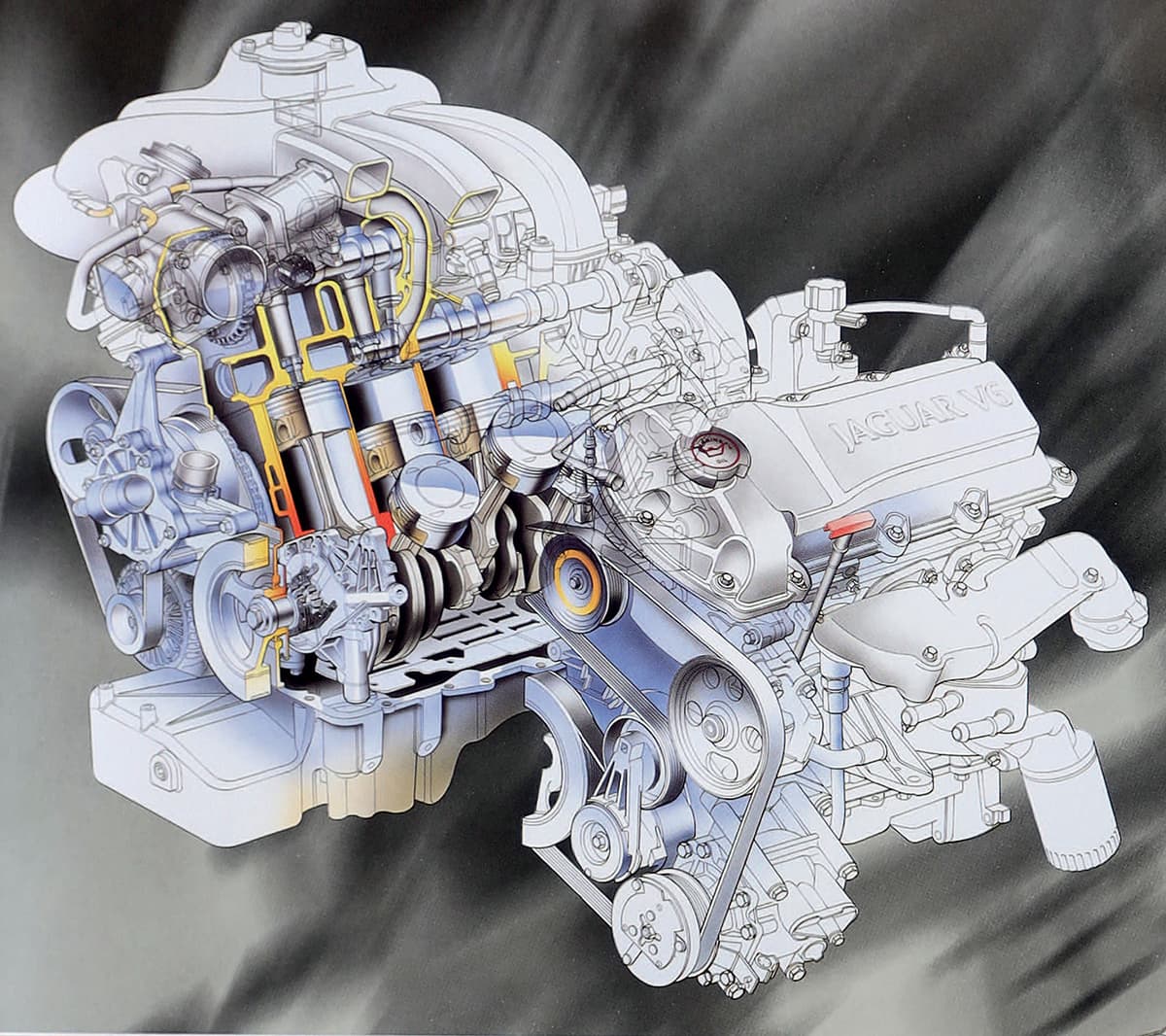
The start of a range of V-6 engines initially in the S-Type, but eventually leading through to all saloon models into the millennium.
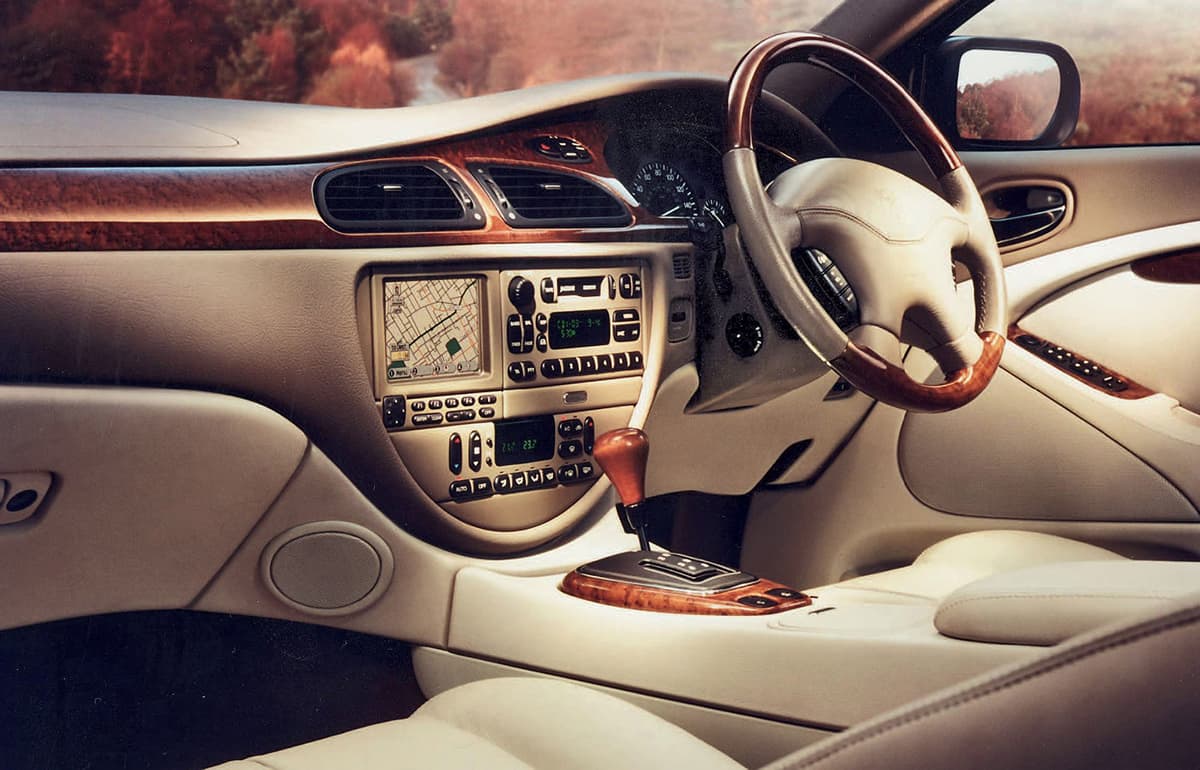
The interior of the early S-Type was a culture shock for many Jaguar traditionalists, governed by certain aspects of the Ford parts bin.
Along with the 4.0-liter V-8, there was a 3.0-liter V-6 developed by Jaguar but shared with the US Lincoln. For this engine, a rigid 60-degree twist-forged steel crankshaft with fully machined balance weights, undercut rolled fillets, and heat-treated pins/journals was used. Camshafts used a low-profile Morse silent dual-chain drive and hydraulic tensioner. Cast-in thin-wall iron cylinder head liners, low-pressure cast heat-treated 319-grade aluminum cylinder heads, cast iron, light silicon/molybdenum exhaust manifolds and directly mounted engine ancillaries completed the specification for the new engine. The 3.0-liter developed 240 brake horsepower at 6,800 rpm.
Two gearboxes were fitted to the early S-Types—a five-speed Ford automatic transmission incorporating Jaguar’s “J-gate” and a Getrag Type 221 five-speed manual gearbox operated through a 240-millimeter diameter self-adjusting clutch.
A bespoke powertrain electronic controller managed primary engine and transmission functions and secondary systems.
A plastic deformable fuel tank was used for the first time, mounted below the rear seat pan.
Front suspension was all independent, with twin unequal length wishbones and coil springs with telescopic shock absorbers. The wishbones were lightweight alloy forgings, the uppers having integrated ball joint, mounted directly to the body. Coil springs were coaxial with the shock absorbers mounted between the lower wishbone and body.
There were two crossbeams. One, a steel fabrication, provided the location for the lower wishbone mounting, anti-roll bar, and engine cooling system; the other (positioned behind the first), was an alloy casting providing the mounting for the rear arms of the lower wishbone, the power steering rack, and engine mounts. An unusual “swan neck” aluminum design front knuckle casting with steering arm provided location for the upper and lower ball joints, disc shields, brake calipers, and wheel bearings with integral wheel speed sensors.
The independent rear suspension was also new. Unequal length twin aluminum wishbones had constant velocity jointed driveshafts. Coil springs, coaxial with shock absorbers, were mounted between the lower wishbone and the body. These were heavily inclined in plan and side views to provide good anti-squat and anti-lift characteristics. The wishbones were mounted on a crossbeam, isolated from the body by bushes, with the steel crossbeam also providing the mounting for the differential and anti-roll bar. Jaguar’s CATS suspension was available for the S-Type as an option.
The steering had electronic control, a speed proportional design with a variable-ratio rack. The braking system incorporated large-diameter ventilated discs (300-millimeter front with twin pistons, 288-millimeter rear with a single piston), with a four-channel anti-lock system incorporating electronic brake distribution and traction control. A conventional handbrake arrangement was used.
Standard equipment wheels were 16-inch, with 17-inch as an option, both with Pirelli tires.
The S-Type was launched in a choice of just three models, the 3.0 liter, 3.0-liter SE (Special Equipment), and 4.0 liter.
Over the first 12 months of production, various color changes took place to match similar changes in the other Jaguar models, and a BBS Monaco 18-inch split-rim alloy became available, part of the new R-Performance options range.
Sales for 1999 surpassed their 75,000 figure from ten years previous. The major contributing factor had been the S-Type with 39,000 sold from April to December, of which 77 percent were exported.
Announced towards the end of 2000 were some upgrades to the S-Type with the power steering following the same changes as other Jaguar models. A Sports Pack became available to upgrade the standard saloon with CATS suspension, 17-inch alloy wheels, and sports seating. An annoying aspect of the early cars was that if a CD auto-change was fitted, it was located in the passenger side glove box taking up most of the space. For the 2001 model year this was removed to the boot area. Under the boot floor a new module had been created to store the jack and tools, previously kept on top, and the side body rubbing strips were removed giving the car a cleaner line.
2001: X Marks the Spot
With the S-Type becoming Jaguar’s most successful saloon ever, reaching nearly 107,000 sales to date, the company announced to the world another small new saloon (coded X-400), the X-Type. The goal was to attract an entirely new market to the brand, the under 40-year-olds, with 80 percent of anticipated sales coming from conquests taken from those who would have normally bought the likes of a BMW 3 Series.
It took a mere two years to launch the X-Type, a car to be built at an ex-Ford facility near Liverpool in which £300 million had been invested. Every aspect of production had been examined carefully to ensure quality and supply. Outside component suppliers were reduced from 350 with the S-Type to just 130 for the X-Type, and 90 percent of the car, by weight, was now recyclable. The body was reportedly 30 percent stiffer than any equivalent-sized saloon from other manufacturers.
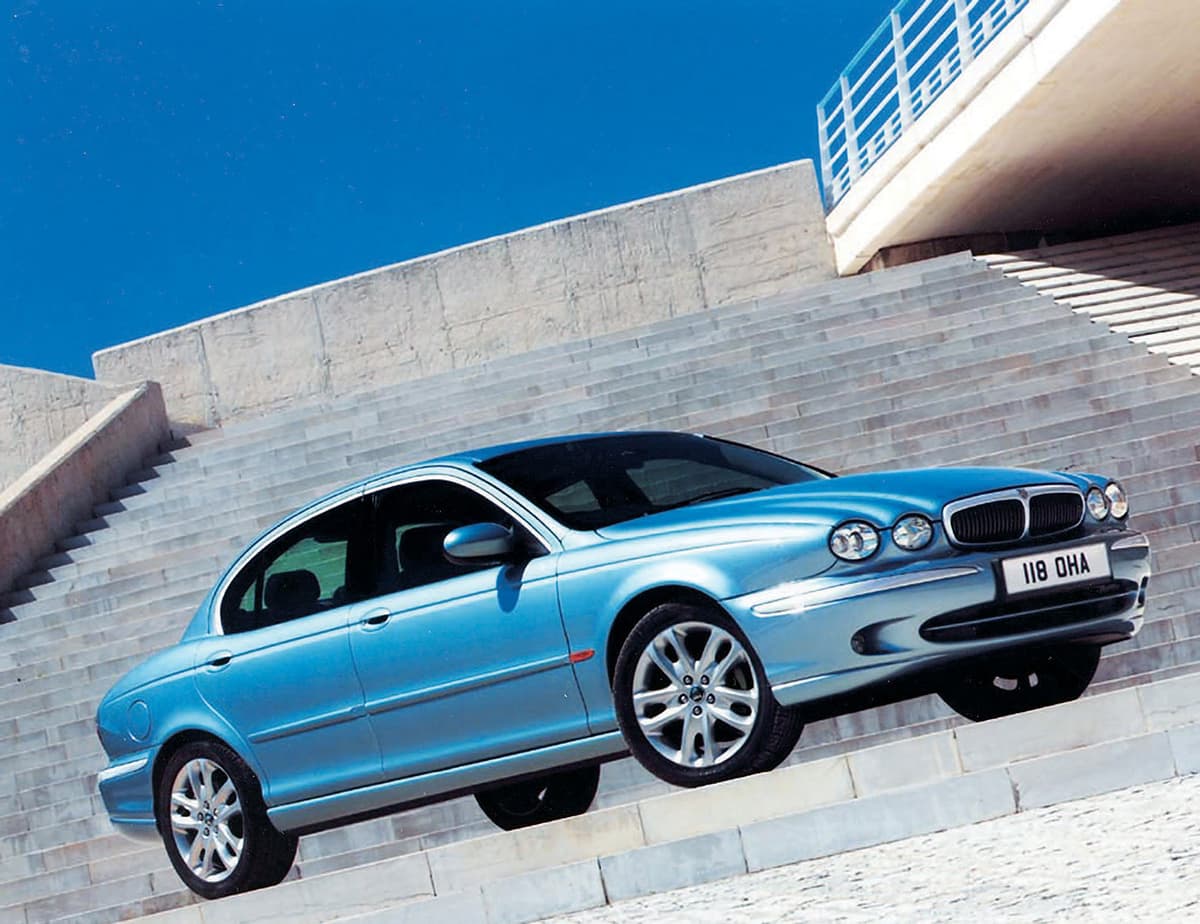
Jaguar’s smaller saloon, the X-Type, with obvious styling connections to its larger brother, the XJ. Although aimed at a new market, there were a significant number of Jaguar owners who took this opportunity to downsize.
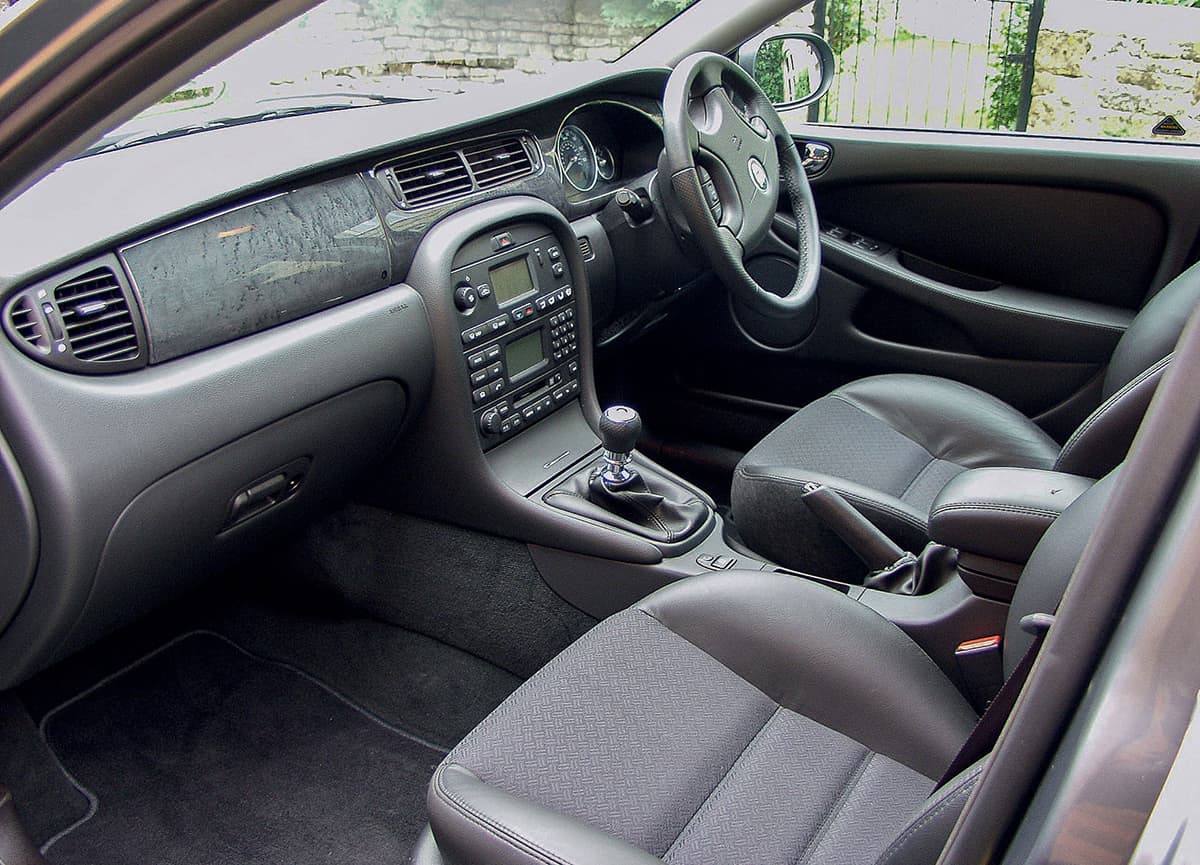
The interior of the X-Type, in this instance a Sport model, with the dark stained woodwork and a new dashboard/console layout that would eventually find its way into other models.
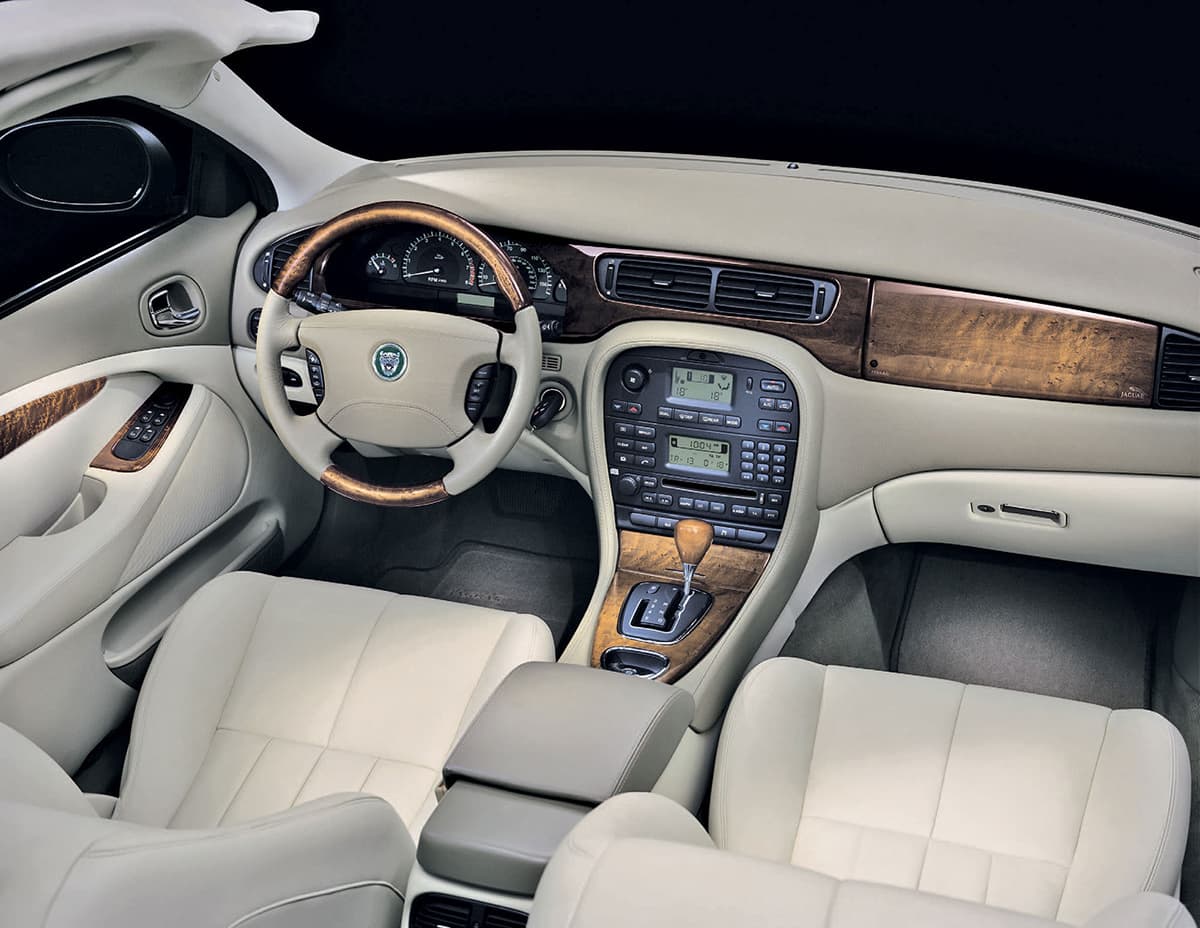
The new interior layout of the S-Type returned to more conventional Jaguar appearance and echoed that of the smaller X-Type.
Styling took cues from the larger XJ but incorporated aspects of the S-Type’s roofline and boot area. Inside was the same, with touches of the XJ plus the S-Type’s instrument pack and better-quality switchgear and trim. For the first time the complete dashboard was assembled as one unit. Top-of-the-line models got a telematics system incorporating 120-watt Alpine sound and a wide touch screen for finger-tip controls of audio, air conditioning, and satellite navigation, plus a TV and phone where fitted.
New seating with a choice of trims provided an enhanced feel of quality and there was more storage space than in other models. The boot area was also quite large.
The X-Type was launched with just two engines, the existing 3.0-liter V-6 (from the S-Type) and a new 2.5-liter V-6 version of it developing 194 brake horsepower. Transmission for either was the five-speed manual or Ford automatic, both from the S-Type.
The X-Type’s biggest innovation was all-wheel-drive. Jaguar’s Traction-4 full-time all-wheel-drive system allowed 60 percent of torque to be delivered to the rear wheels to provide the feel of conventional rear-wheel drive. If the system’s sensors detected a speed difference between the front and rear road wheels, torque could be transferred via a viscous coupling to correct the imbalance.
The front suspension had two bearing top mounts and twin-tube McPherson struts with Hydrobushes for better compliance. The rear axle/suspension assembly was unique to this model, although in both front and rear situations, many components came from the Ford parts bin.
The X-Type was launched initially in a choice of six models, standard trim, SE (Special Equipment) and Sport, with the 2.5- or 3.0-liter engine. The Sport option included a discreet boot spoiler, 17-inch wheels, matte black window surrounds, color keyed bumper blades, grille, gray stained wood veneer, and stiffer suspension settings. The Sport theme had been started on previous XJ models, commencing with the XJ40 and the X-Type followed this pattern to appeal to a younger market.
The same principle followed now with the S-Type, as a Sport version of that became available during 2001. Dechroming of exterior brightwork was the first noticeable difference, along with a mesh grille plus a more contemporary interior look with the dark stained woodwork and sportier seating. Wider wheels were standard.
By the end of 2001, S-Type sales for the year were down to 38,325, while the X-Type in its first year of production achieved sales of 55,616.
2002: New Power Units and a New Car
Much was afoot in 2002. Despite the initial success of the X-Type, it made no inroads on BMW’s 3 Series market because the majority of those sales came at the entry level, below the X-Type’s UK price of £20,000 (also a company car taxation limit). To rectify this, Jaguar introduced a new engine in all three forms—X-Type, X-Type Sport, and X-Type SE.
The engine was a 2,099cc, 24-valve, four-camshaft V-6 delivering 157 brake horsepower with torque of 148 pounds-feet for an estimated top speed of 130 miles per hour. Derived from the existing 2.5-liter V-6, it had the same bore but with a 66.8- millimeter stroke.
The 2.0-liter models were front-wheel drive. The drive was connected via equal-length half shafts, the geometry calculated to ensure they were perfectly aligned under torque. Special constant-velocity joints at the outward ends reduced friction, and unique strut top mounts were used to eliminate friction there under torque.
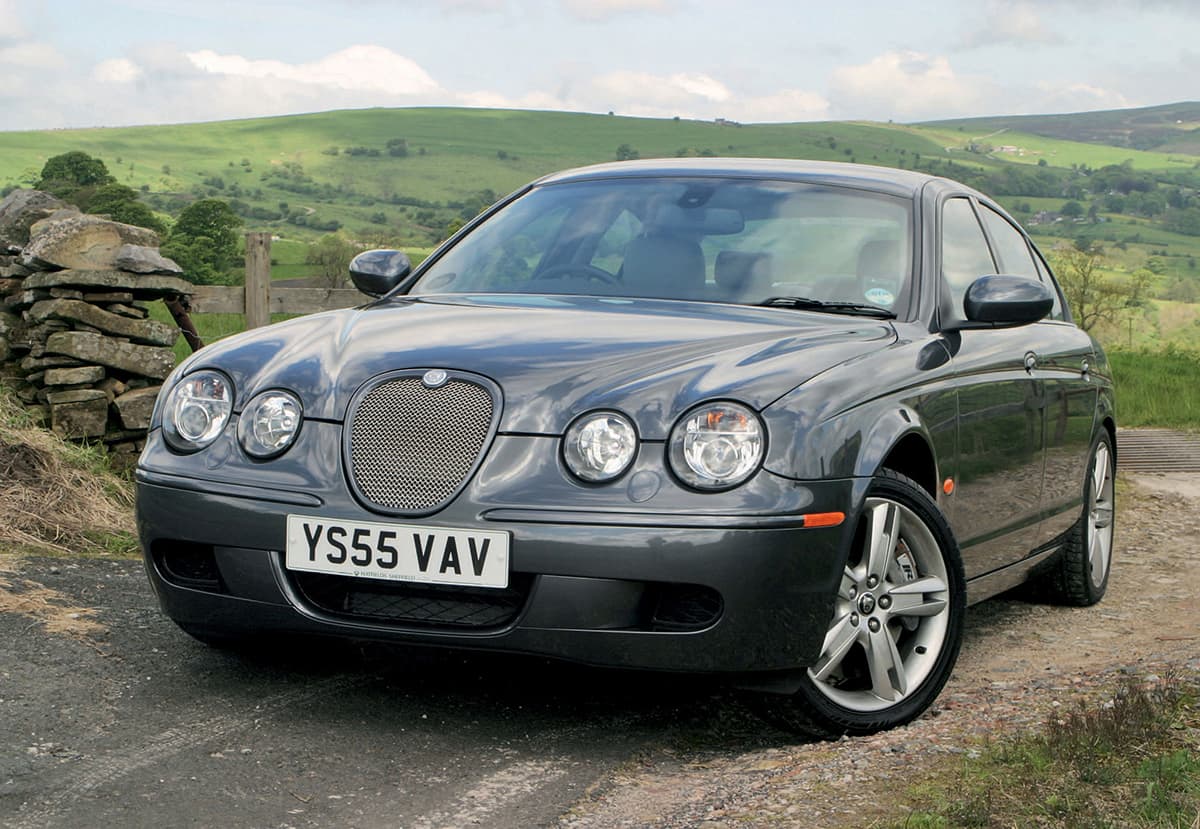
The announcement of the supercharged S-Type R meant a revised appearance for that model.
Retuned suspension matched the new engine and car weight. Standard equipment was the Getrag gearbox with revised ratios; a Jatco FPD five-speed automatic was also available.
The S-Type bodyshell was reengineered, reportedly now 10 percent stiffer through the use of laser-welded roof joints and high-strength steel in key areas and better-quality fit to incorporate new side-curtain airbags.
At the front, there was a new grille incorporating a growler badge and modified surround. Xenon lighting was now available as well. From the side, as with other models, the rubbing strips were removed, and there were new door mirrors and a wider choice of alloy wheels.
Due to some complaints about the interior, there was a complete change adopting the same style as the X-Type, which itself was similar to an XJ! This included the telematics system and other enhancements standardized from the X-Type, like uprated sound systems. There was also additional storage plus modified door panels and other trim.
To improve comfort, foot pedals could be adjusted electrically by a control in the driver’s door. There were now no fewer than three seat combinations depending on model, all using magnesium seat frames for lightness, and with electric seat adjustment.
Safety enhancements followed current Jaguar practice from the other models, including Adaptive Restraint Technology.
Mechanically there were new engines and transmission. These included the 2.5-liter V-6 used in the X-Type, yet retaining the S-Type’s rear-wheel drive. The 3.0-liter engine came in for some minor revision to improve fuel economy by revising the three-stage variable geometry induction system and cam phasing.
The 4.0-liter engine had been upgraded to 4.2 liters and was now fitted to the S-Type. Adding the supercharged version created the S-Type R model, one of the fastest in its class. For use in the S-Type, supercharger speeds were increased by 5 percent.
Manual transmission remained unchanged, but the new six-speed Mercedes automatic was now fitted to V-8 S-Types.
S-Type suspension was now somewhat standardized with other models, particularly the X-Type, stiffened up to suit the S-Type R’s extra performance requirements. An industry first at the time was an electronic parking brake for the automatic transmission models. A switch on the center console applied or released the handbrake mechanism, or it was done automatically upon removing the ignition or when accelerating from a standstill. The system worked by applying caliper levers through a parking brake actuator mounted on the rear subframe with an electronic control unit mounted in the boot. Larger brake discs were now fitted to S-Types incorporating the four-channel anti-lock system and panic-assist feature.
At the 2002 British Motor Show, Jaguar presented the special limited-edition X-Type Indianapolis, a model available only in three colors: Ebony Black, Platinum Silver, or Ultraviolet Blue with Alcantara black sports seating and special veneers. Sitting on 18-inch wheels, the model was available with either the 2.5-liter or 3.0-liter V-6 engines. Standard equipment included xenon headlights, air conditioning, and reverse park aid.
Although sales through 2002 had fallen somewhat for the S-Type, the overall figures were still excellent at 36,000 units, while the X-Type was at its peak, almost doubling S-Type sales to over 69,000.
2003: New XJ
In 2002, Jaguar introduced the New XJ (coded X-350), identifying it as “The Most Advanced Car Ever.” To avoid too radical a style departure, the design featured a somewhat reinvigorated body with a lot of elements relating to the much smaller X-Type but all the better for the larger dimensions. Larger overall than any previous XJ, the car had more room inside and in the boot area.
From the front the established four-headlight styling of all XJs was continued with more modern lighting, another revised grille (individually designed according to model), the bumper bar of the current “corporate” style with chromed blades and integrated auxiliary lighting. The bonnet was marginally shorter, wheels were positioned closer to the extremities of the body and filled the wheel arches better. The rear area was smartened up, yet still easily identifiable as an XJ.
Despite similarities to what had gone before, the X-350’s styling hid Jaguar’s new all-aluminum bodywork with lighter magnesium crossbeam along the bulkhead and for the interior seat frames. The car also featured an industry-first rivet-bonded joining of panels using self-piercing rivets combined with aerospace-sourced epoxy adhesives to join the aluminum pressings and castings. The body was also built from fewer panels than previously, producing a car that was not only 60 percent stiffer but also 40 percent lighter.
The car initially came with a choice of four engines, the existing 3.0-liter V-6 (reinstating the XJ6 name), the 4.2-liter V-8, and the 4.2-liter supercharged V-8, plus a new 3.5-liter V-8 (derived from the 4.2) providing 262 brake horsepower, all mated to Jaguar’s XF six-speed automatic transmission.
An entirely new suspension system brought the X-350 into a new realm of ride, comfort, and dynamic quality. The mechanicals were based on the S-Type and incorporated a self-leveling air suspension system. This ensured that full suspension travel was always available by increasing the spring’s stiffness relative to payload. It also ensured that the car had consistent ride height and the ability to adapt to changing circumstances. A new version of Jaguar’s CATS suspension was also fitted to all New XJs.
The interior of the cars was also new, following the design influences from the X-Type and later S-Types, along with quality switchgear, ventilation outlets, and Piano Black finished trim. Head, shoulder, and leg room were all improved and there was an extensive range of standard features as befitting the top-of-the-range models. Voice activation, electrically adjustable pedals, electrically controlled rear screen blind, and heated front screen were just a few of the features now available.
There were lots of first-time features for the XJ including radio signal pick-up embedded in the rear screen (no separate aerial), heated elements in the base of the front screen to prevent the wipers from freezing up in extreme conditions, and ground illumination that used the key fob to trigger lights under the door mirrors to assist in approaching the car in the dark. There was even a rear compartment console to control the audio/TV/video systems when fitted, with plug-in facilities for games consoles and headphones, and a four-zone air conditioning system.
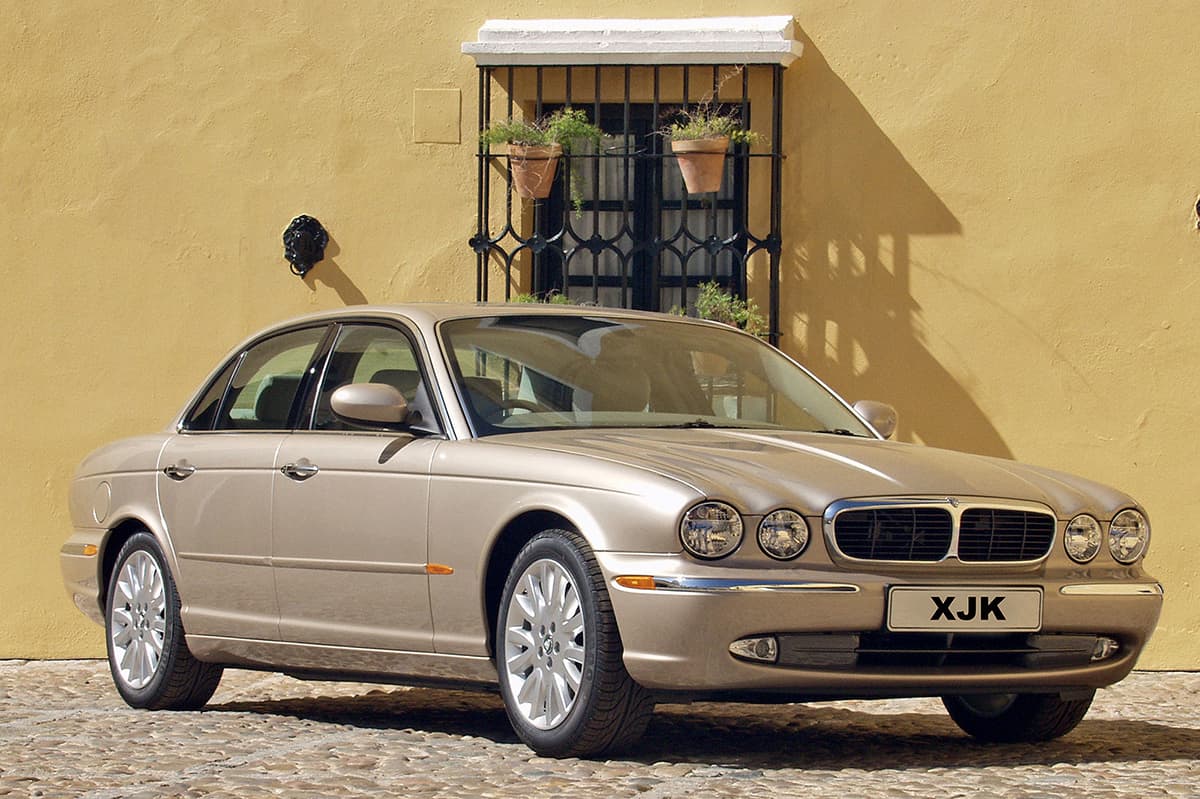
The New XJ at launch in 2003, in many ways looking like the model it replaced, but larger, with improved build quality, finish, and fitment. This is the entry model 3.0-liter XJ6, the first time that insignia had been used since the demise of the AJ16-engined model in 1997.
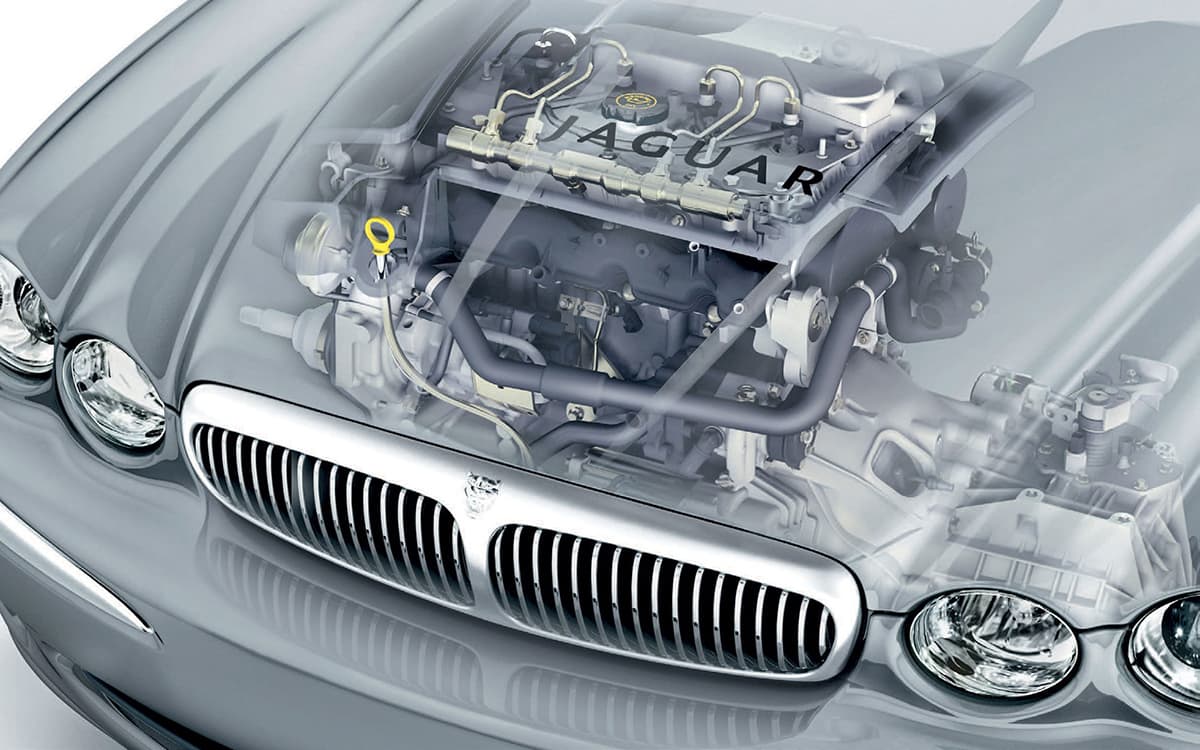
With the introduction of new, smaller engines for the X-Type, an economical 2.0-liter diesel (from Ford’s stable) would be installed, unusually in the transverse position with front-wheel drive only.
Additional innovations included a smart charging system to manage the battery load, cutting nonessential power if the battery was not at a reasonable charge, and a digital data bus fiber-optic communications system delivering high-speed information to relevant systems.
At launch, the range consisted of the XJ6 (3.0-liter V-6), the Sport (V-6 or 4.2-liter V-8), the SE—Special Equipment (all three normally aspirated engines), XJR (supercharged 4.2-liter V-8), and the Super V-8 (supercharged 4.2-liter V-8). There was only one (short) wheelbase bodyshell available and no Daimler-badged edition.
Returning to Jaguar’s successful X-Type, another first in 2003 was the introduction of Jaguar’s first diesel engine, a four-cylinder 1,998cc unit tracing back to the Ford TDCi unit. The engine developed 128 brake horsepower at 3,800 rpm with 243 pounds-feet of torque at just 1,800 rpm. The engine was lightweight with a stiff cast iron block with an aluminum ladder frame and aluminum cylinder head. Fuel injection was based on a high-pressure common rail direct system with variable geometry turbocharger.
Installation of the new engine in the X-Type was transverse, transmitting power through a standard X-Type five-speed manual gearbox to the front wheels. Significant sound deadening was added to the X-Type’s bodyshell to eliminate noise, and changes were made to spring rates to match the altered weight of the power unit.
By the end of 2003, S-Type sales had amounted to 32,000 cars; X-Types were double that at 61,600 and the New XJ had sold a very healthy total of 30,800!
2004: “Extending” the Range
Jaguar had a busy 2004, starting with a significant facelift for the S-Type. At the front was a new look with a simpler but more assertive bumper design that varied according to model. Another new radiator grille appeared, set lower and wider, and the bonnet was made from aluminum with subtle changes to the curvature.
From the sideview, the sills had been resculpted to blend better into the overall styling of the car. The bumper bar wraparounds were also altered with a different depth to the “blades.” The rear wing line, upper and lower bumper surfaces, and boot lid were all reshaped.
More significant changes took place at the rear with less curvature to many panels; chrome finishers and locks were changed, and the modern light units now wrapped over the tops of the wings. Bumper bar treatment was simplified and badging changed.
The changes improved aerodynamics and gave the S-Type a slightly more aggressive look as well as a more polished style.
Internally, although the general layout remained unaltered, the instrument array changed with clearer dials, and two message centers provided more information. Four trim options were now available with a new alloy finish or Bronze Madrona, Grey Bird’s Eye Maple, or Burr Walnut veneer. There was also a Luxury Pack available with soft-grain leather, chrome highlights, a matching wood/leather steering wheel, and heated seats. Seat upholstery range was extended with a choice of cloth, conventional or perforated, or R-leather, with the option of dual-colored trim. Equipment levels were also enhanced.
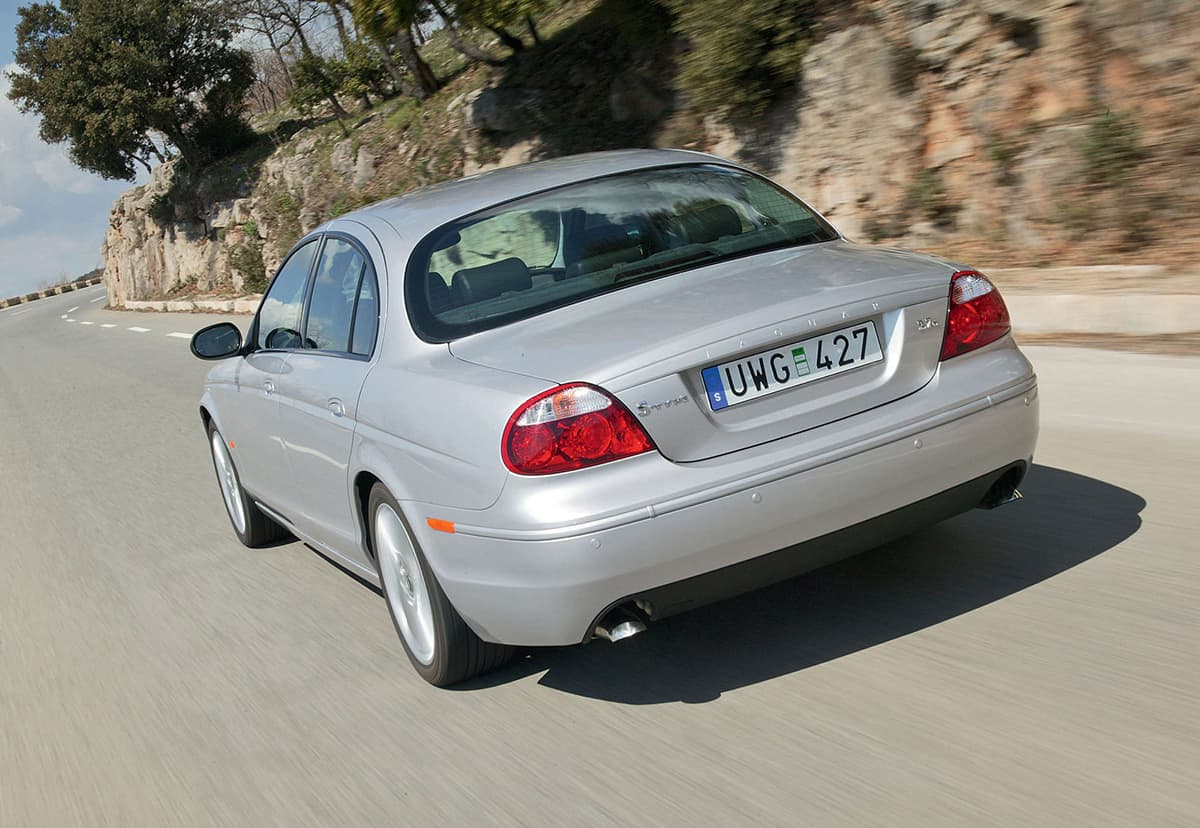
The facelifted S-Type from the rear with its cleaner lines, revised bumper treatment, and cleaner sides.
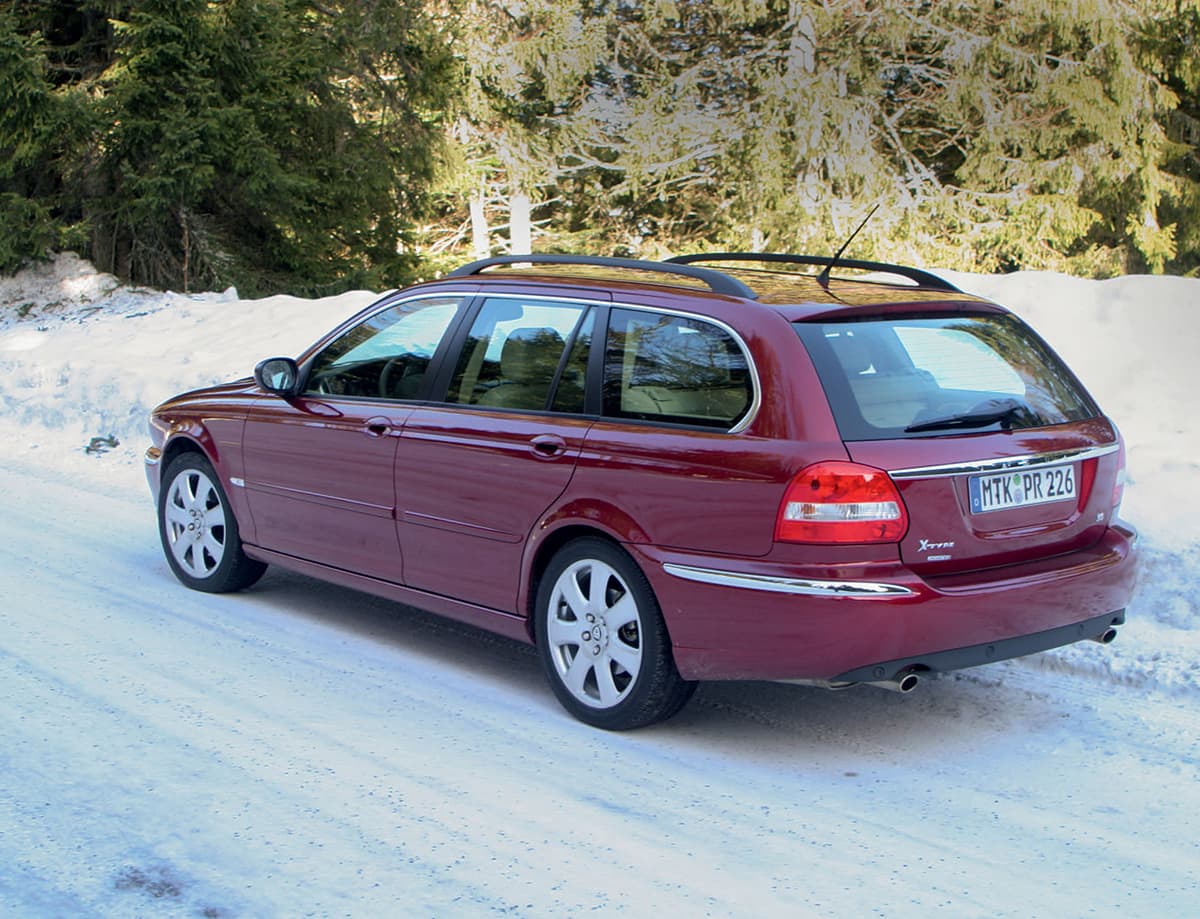
The first production estate car from the company, based on the X-Type, was a very attractive and uncompromised design that was received well by the public.
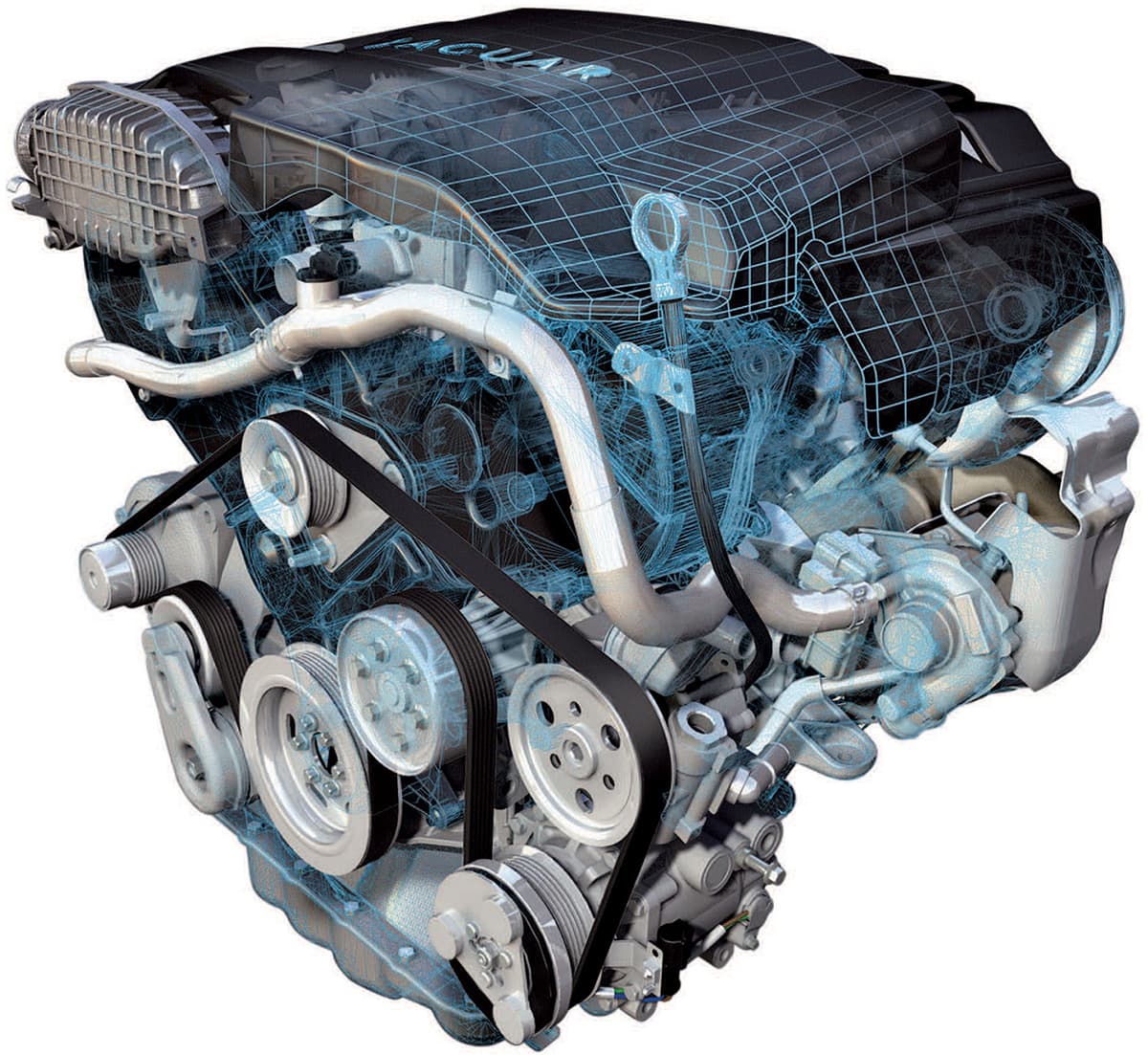
The 2.7-liter V-6 twin-turbo-charged diesel engine, a collaboration between Jaguar, Ford, and Peugeot-Citroen, was the most powerful diesel offered by Jaguar until it was replaced by an entirely new 3.0-liter engine.
With an expanding market for diesel cars, Jaguar had to address it, so for 2004 the S-Type became available with a new 2.7-liter engine jointly developed with Ford and Peugeot-Citroen. The new block was made from compacted graphite iron. A four-camshaft unit with twin turbochargers and 24 valves, it produced over 200 brake horsepower with more torque than Jaguar’s 4.2-liter V-8. Built for quiet running, it was also 40 percent more fuel efficient and only 15-kilograms heavier than an equivalent gasoline unit.
Installation of the diesel engine in the S-Type involved significant sound deadening work, like a double-skinned sump and an elastomeric-isolated composite cam cover. The suspension underwent changes with revised spring rates and shock absorbers, low-friction ball joints, and the steering control was recalibrated. The engine was built at Ford’s Dagenham Diesel Center in the UK.
The new engine was mated to an adapted version of the six-speed automatic transmission. A diesel-equipped S-Type was marginally cheaper to buy than an equivalent gasoline version.
For the X-Type came not a facelift but another new model, the first Jaguar production estate car. The market sector for cars of this size indicated that 18 percent of all new models sold were estate cars, so it was an obvious move for Jaguar to produce one to captivate an even larger market share.
Producing the estate around the existing X-Type bodyshell meant redesigning everything from the B/C post back; even the “Coke bottle” haunch over the rear wings was removed to ensure a smoothness of line. The “taper” of the saloon’s rear wings was also removed so the tailgate opening could be as wide as possible. An increased wraparound of the rear light units helped compensate for this. The roofline was extended and flattened, which meant changes to the door frames. This all resulted in an even stiffer bodyshell.
The tailgate was made up of two sections allowing the whole door to be opened. It was hinged from the top for ease of access, but the upper glass area could be opened separately if needed. Roof rails were fitted to all models finished in either black or silver.
Inside, all the changes focused on the rear compartment/luggage area. New style rear seating had the usual 60/40 split but also could be folded completely down to maximize the loading space. As well as a cargo cover that could be pulled out from a removable cassette by the rear seat, there was an extendable net to affix to points in the roof to protect against luggage moving forward, or as a pet guard. The load area was carpeted with scuff plates and underfloor storage, which included space for a laptop with plug-in point for charging.
Coinciding with the X-Type saloons, minor changes took place like a revised grille and bumper bar, and new steering wheel design.
Mechanically the estate was unaltered from the saloon, except for revised spring rates and other suspension upgrades.
For 2004, history repeated itself with the introduction of a long wheelbase XJ bodyshell for many models. A more integrated design than previous LWB XJs, the new model was only 24kg heavier than the conventional wheelbase car. The extra 5 inches in body length (with a marginal increase in the roof height) all took place after the B/C post, requiring only 17 new body components. The new model wasn’t available with the 3.0-liter V-6 engine; otherwise, it was mechanically a conventional XJ apart from some suspension tweaks and a slightly wider turning circle.
Inside, the rear compartment was conventional except for additional legroom. Alternatively, the buyer could opt for a bench seat with four-way electrical lumber adjustment, powered seat recline and headrests, and the ability via a switch to move the front passenger seat forward to provide even more rear legroom. Additional fold-down business trays could be specified in the rear of the front seats, while screens inset into the rear of the front headrests provided multimedia access.
2005: Another New Diesel
The big news for the X-Type in 2005 was another new engine, a larger 2.2-liter diesel unit, again engineered by Ford, mated to a six-speed manual transmission. Offering 155 brake horsepower with a massive 360 pound-feet of torque at just 1,800 rpm, it provided much-improved performance, with good economy.
Also that year, a Sports Collection Pack became available with a new front spoiler, black grilles, dechroming of exterior trim, revised sill covers, and small boot spoiler, all of which subsequently appeared on a special edition XS model.
Similar treatment was offered for the S-Type models, but this year the 2.5-liter engine was dropped from the range.
A new edition to the XJ range was the Sport Premium, offering a higher degree of specification within the Sport model. Initially available with only the 3.5-liter engine, it later became an option for other models, earlier Sport models eventually being dropped.
2006: XJ Enhancements and a Return of Daimler
At the British Motor Show in 2006, Jaguar introduced their very exclusive XJ Portfolio for the UK market, limited to 100 examples. Effectively a production version of the Concept Eight, and based on the XJR, the car came only in Ultimate Black paint with Ivory leather and alloy interior; it featured highly polished 20-inch Callisto alloy wheels and the wing side power vents in alloy.
Late in the year, anticipating the 2007 MY, various changes took place to the XJ range. Mesh grilles became a standard fit on all models, windscreen and rear screen moldings were removed with direct sealing of the glass, and the side rubbing strips were discontinued. Heated front seats were standardized on all models and a revised palette of interior and exterior colors were instigated. A tire pressure monitoring system became available as an extra-cost option, along with an automatic speed limiter. Bluetooth connectivity also became available.
There was also a return of the Daimler brand, under pressure from traditional customers. The car was effectively a Super V-8 long wheelbase model only available to special order. With the usual Daimler touches of the fluted grille and badges, and as a top-of-the-range model again, it had all the normal extras as standard equipment including rear business tables and the finest leather and wood trim.
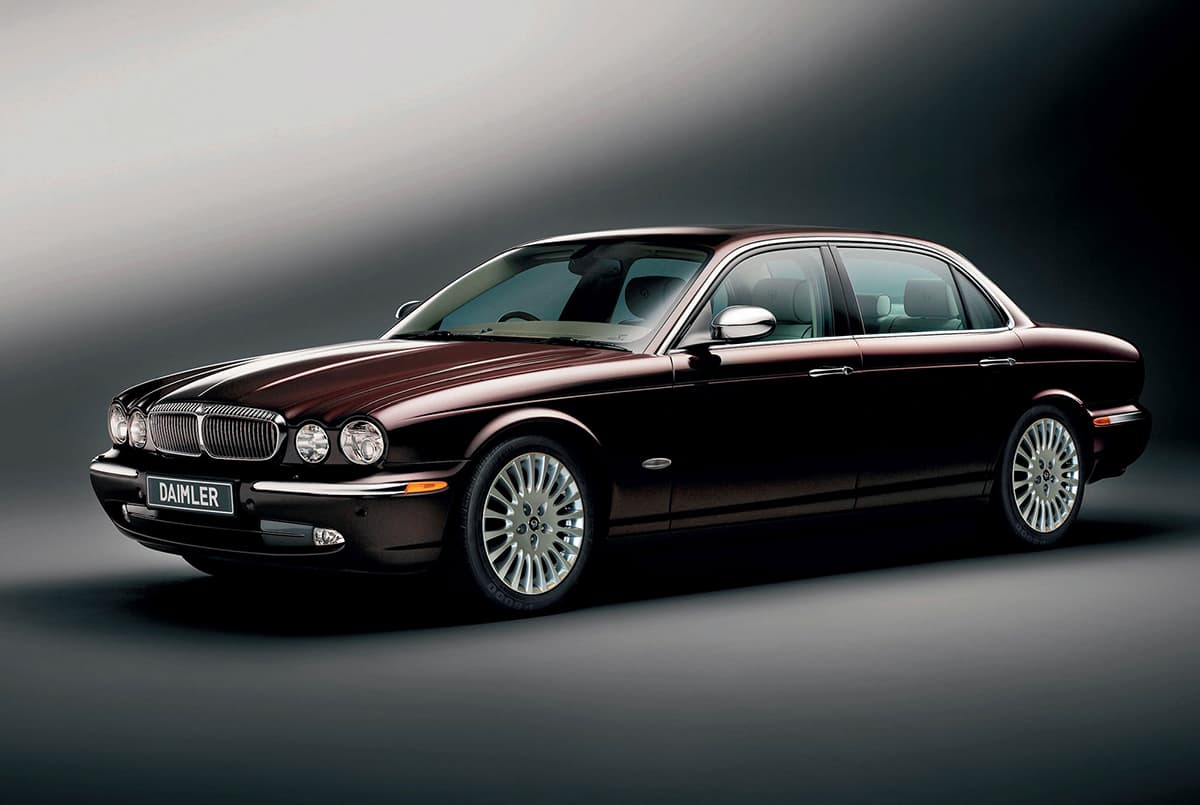
Jaguar reintroduced the Daimler brand in 2006 for a top-of-the-range X-350, but available only for the UK market and then as a special order.
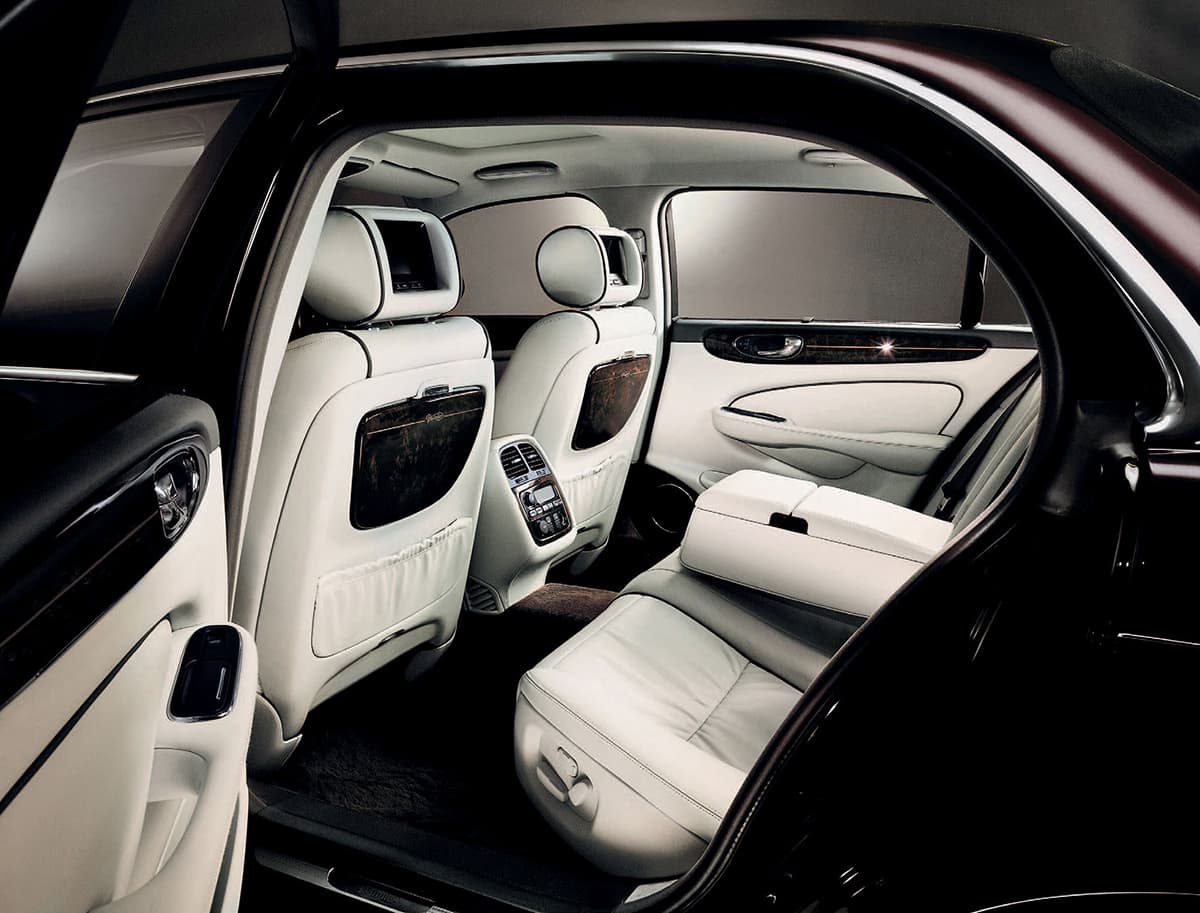
The luxurious interior of the Daimler, most of which would later be available for the Jaguar Super V-8, a car that also satisfied this market in the States.
2007–2008: The End Is Near
With Jaguar readying to introduce new models to replace their existing saloons, 2007 and 2008 presented the opportunity to make final changes to the range.
All S-Types now gained the front bumper treatment of the R model with the deeper mouth, plus a new range of alloy wheels. The XS that was initially a special edition was now a mainstream model replacing the Sport. Interiors were enhanced with multiadjustable seating with nonperforated leather of a more contemporary style for the SE. Entry models got better trim with Satin Mahogany veneer.
The range was simplified with the Spirit (base model), XS, SE in 2.7-liter diesel or 3.0-liter gasoline, and the 4.2-liter R.
Next, it was time for a facelift of the XJ saloons (now coded X-358). The front end was rejuvenated with a new bumper featuring a deeper pronounced mouth and smaller grilles either side with flush fitting auxiliary lighting. A new radiator grille, again more prominent with a new aggressive growler badge, completed the look.
From the side power vents, like those on the concept car and the XK sports car, appeared in the front wings in body color, while the sills were lowered to match the line of the new bumpers. New door mirrors incorporated indicator lights and new style alloy wheels were available.
At the rear, came another new bumper to match the front, new exhaust tailpipes, a discreet spoiler on the boot lid, and a full-width finisher in chrome or body color.
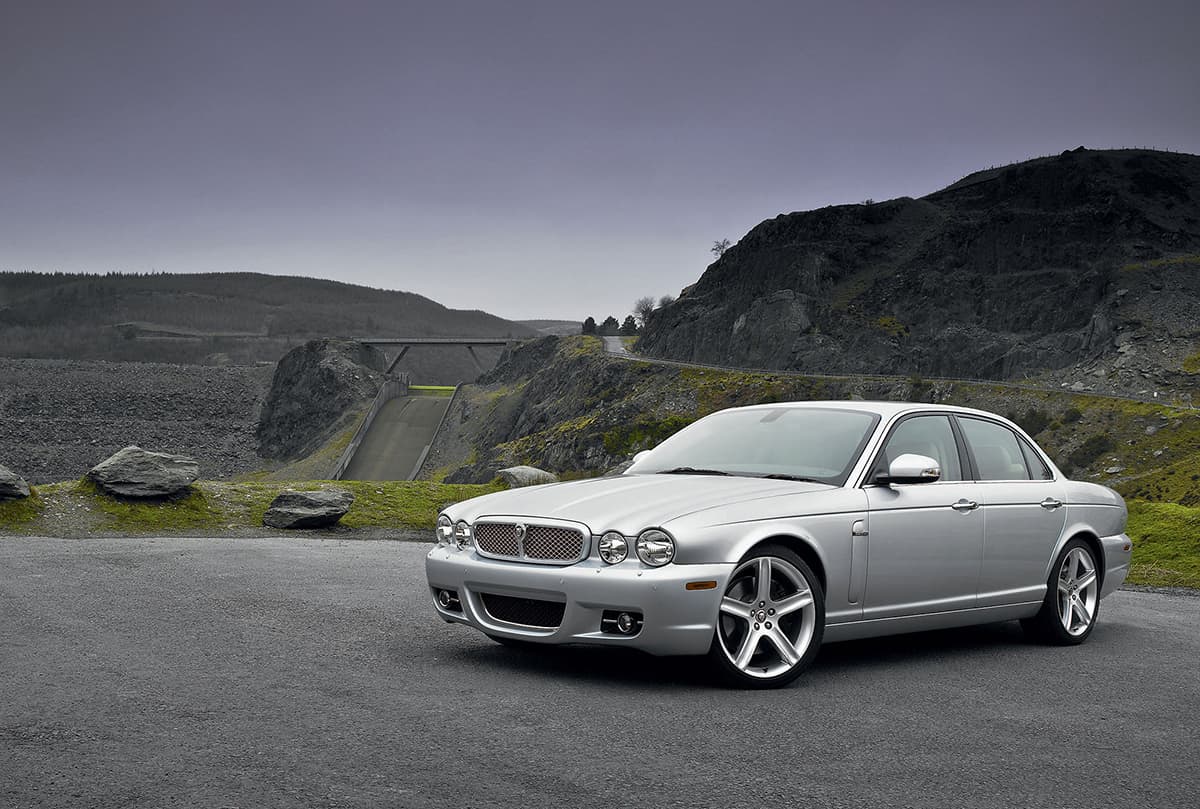
The facelifted XJ with its more aggressive front styling.
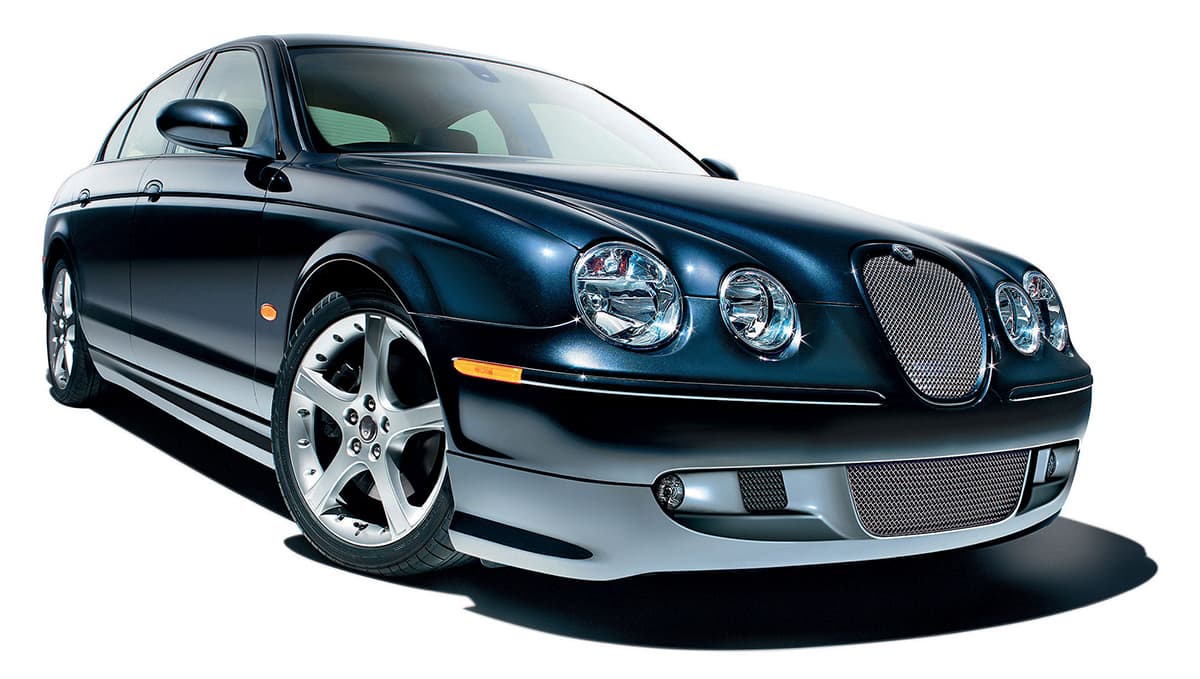
The revitalized S-Type nearing the end of production with the XS model.
Internally, there was new seating with softer cushions and, due to the redesign, there was more legroom in the rear compartment. Chrome detailing was applied to a lot of the switchgear and infotainment was enhanced with Bluetooth connectivity. Voice control was now possible with many features.
Finally the XJ range was simplified, based on the XJ Executive in 2.7-liter diesel and 3.0-liter gasoline form (the entry model), XJ Sovereign (2.7 liter/3.0 liter/4.2 liter) high-end model, the XJ Sport Premium (2.7-liter diesel) with sporting touches and stiffer suspension settings, and the XJR (4.2 liter) supercharged model.
Now it was the turn of the X-Type and the biggest change here was the availability of a six-speed automatic transmission with sequential gear change for the 2.2-liter diesel. Although the six-speed manual gearbox was able to achieve maximum torque in second gear, the new automatic provided that in all gears, ensuring no loss in performance as would normally be the case with automatics.
The revised X-Types now had better communications systems, again with Bluetooth, and improved audio systems.
X-Types received a fresh look, taking cues from the new XJs with the more prominent grille and surround, new growler style badge, new bumper treatment, similar treatment at the rear, and lowered sills, new mirrors and badging.
The interior makeover included a host of new trim options and even the instrument panel got a new look, which was obviously planned for its replacement model, yet to be seen.
As with the other models, the range was rationalized to 2.0-liter and 2.2-liter diesel car and estate, in X-Type, X-Type S, X-Type Sovereign, and X-Type Sport Premium.
Both the S-Type and X-Type would later give way to Jaguar’s new XF range and the XJ would soldier on to 2008 to be deleted a few months prior to the introduction of another new XJ in 2009. A total of 291,000 S-Types, 355,000 X-Types, and 83,500 XJs had been produced.
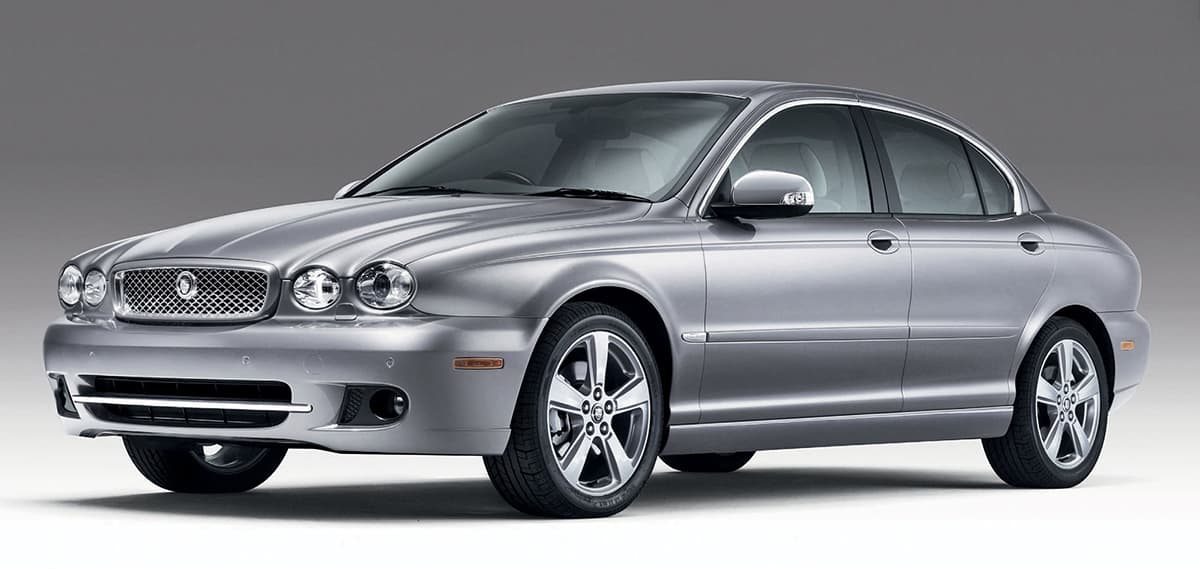
Last-of-the-line X-Type with various styling changes.
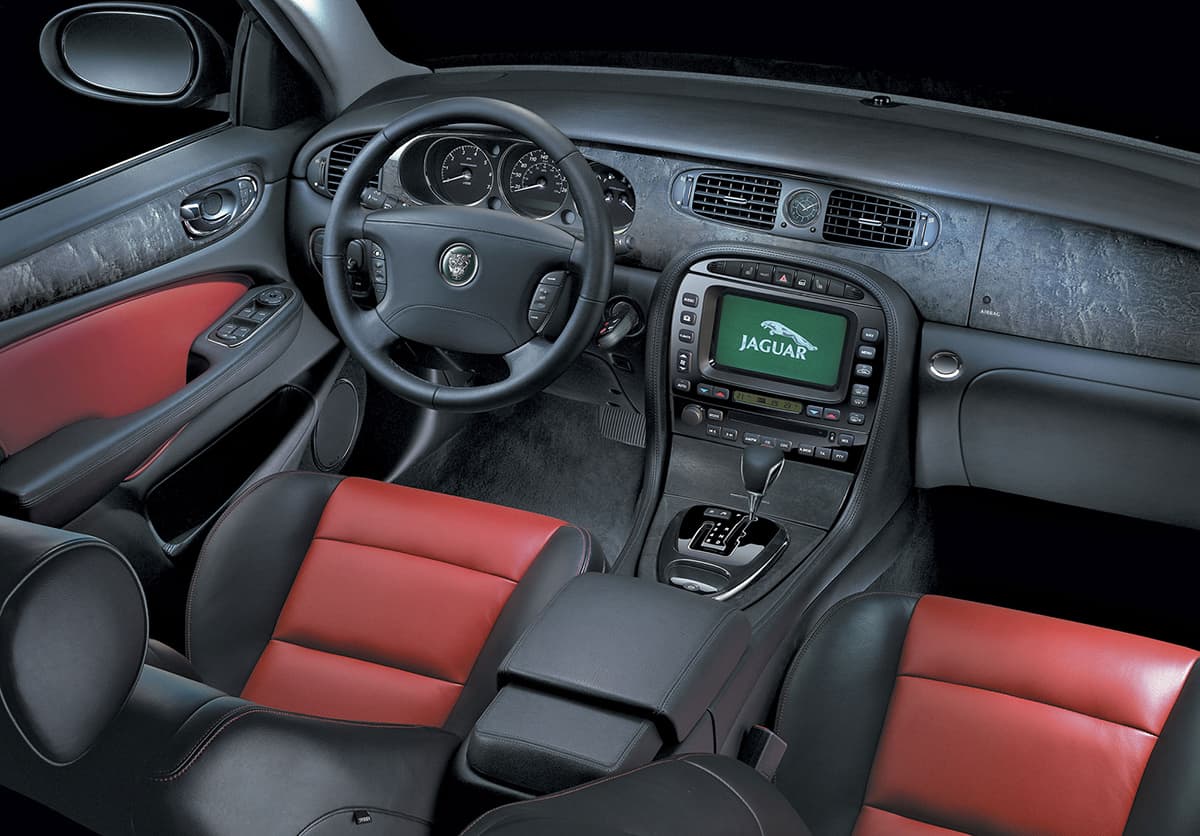
Typical Jaguar XJ interior with dual-colored upholstery, a feature that also became available for the S-Type and X-Type saloons.
SPECIFICATIONS
MODEL |
2.5-liter V-6 S-Type |
2.7-liter D V-6 S-Type |
3.0-liter V-6 S-Type |
ENGINE SIZE |
2,497cc |
2,720cc |
2,967cc |
CARBURETION |
Fuel Injection |
Fuel Injection |
Fuel Injection |
MAXIMUM BHP |
201@6,800 |
206@4,000 |
240@6,800 |
MAXIMUM TORQUE |
184@4,000 |
320@1,900 |
221@4,500 |
GEARBOX |
5-speed |
n/a |
5-speed |
AUTOMATIC |
5-speed |
6-speed |
5-speed |
0 TO 60 MPH |
8.2 sec. |
8.1 sec. |
6.9 sec. |
TOP SPEED |
142 mph |
143 mph |
146 mph |
AVERAGE FUEL CONSUMPTION |
25.4 mpg |
36 mpg |
22.7 mpg |
MODEL |
4.0-liter V-8 S-Type |
4.2-liter S-Type |
4.2-liter S-Type R |
ENGINE SIZE |
3,996cc |
4,196cc |
4,196cc |
CARBURETION |
Fuel Injection |
Fuel Injection |
Fuel Injection |
MAXIMUM BHP |
281@6,100 |
300@6,000 |
400@6,100 |
MAXIMUM TORQUE |
287@4,300 |
310@4,100 |
408@3,500 |
GEARBOX |
n/a |
n/a |
n/a |
AUTOMATIC |
5-speed |
6-speed |
6-speed |
0 TO 60 MPH |
6.6 sec. |
6.2 sec. |
5.3 sec. |
TOP SPEED |
150 mph |
155 mph |
155 mph |
AVERAGE FUEL CONSUMPTION |
24.5 mpg |
22.5 mpg |
22.5 mpg |
MODEL |
2.0-liter X-Type |
2.0-liter D X-Type |
2.2-liter D X-Type |
ENGINE SIZE |
2,099cc |
1,998cc |
2,198cc |
CARBURETION |
Fuel Injection |
Fuel Injection |
Fuel Injection |
MAXIMUM BHP |
157@6,800 |
128@3,800 |
155@3,500 |
MAXIMUM TORQUE |
148@4,100 |
243@1,800 |
360@1,800 |
GEARBOX |
5-speed |
5 or 6-speed |
6-speed |
AUTOMATIC |
5-speed |
n/a |
6-speed |
0 TO 60 MPH |
8.9 sec. |
9.5 sec. |
8.5 sec. |
TOP SPEED |
130 mph |
125 mph |
137 mph |
AVERAGE FUEL CONSUMPTION |
30.7 mpg |
50.3 mpg |
47 mpg |
MODEL |
2.5-liter X-Type |
3.0-liter X-Type |
ENGINE SIZE |
2,495cc |
2,967cc |
CARBURETION |
Fuel Injection |
Fuel Injection |
MAXIMUM BHP |
194@6,800 |
231@6,800 |
MAXIMUM TORQUE |
180@3,000 |
209@3,000 |
GEARBOX |
5 or 6-speed |
5 or 6-speed |
AUTOMATIC |
5-speed |
5-speed |
0 TO 60 MPH |
7.9 sec. |
6.6 sec. |
TOP SPEED |
140 mph |
146 mph |
AVERAGE FUEL CONSUMPTION |
29.5 mpg |
27.5 mpg |
SPECIFICATIONS
MODEL |
2.7-liter D X-350 |
3.0-liter XJ6 |
3.5-liter XJ6 |
ENGINE SIZE |
2,722cc |
2,967cc |
3,555cc |
CARBURETION |
Fuel Injection |
Fuel Injection |
Fuel Injection |
MAXIMUM BHP |
204@4,000 |
240@6,800 |
262@6,250 |
MAXIMUM TORQUE |
321@1,900 |
221@4,100 |
254@4,200 |
GEARBOX |
n/a |
n/a |
n/a |
AUTOMATIC |
6-speed |
6-speed |
6-speed |
0 TO 60 MPH |
7.8 sec. |
7.8 sec. |
7.3 sec. |
TOP SPEED |
141 mph |
145 mph |
150 mph |
AVERAGE FUEL CONSUMPTION |
35 mpg |
27 mpg |
26.5 mpg |
MODEL |
4.2-liter XJ8 |
4.2-liter XJ8 R |
ENGINE SIZE |
4,196cc |
4,196 |
CARBURETION |
Fuel Injection |
Fuel Injection |
MAXIMUM BHP |
300@6,000 |
400@6,100 |
MAXIMUM TORQUE |
310@4,100 |
408@3,500 |
GEARBOX |
n/a |
n/a |
AUTOMATIC |
6-speed |
6-speed |
0 TO 60 MPH |
6.3 sec. |
5 sec. |
TOP SPEED |
155 mph |
155 mph |
AVERAGE FUEL CONSUMPTION |
26 mpg |
23 mpg |